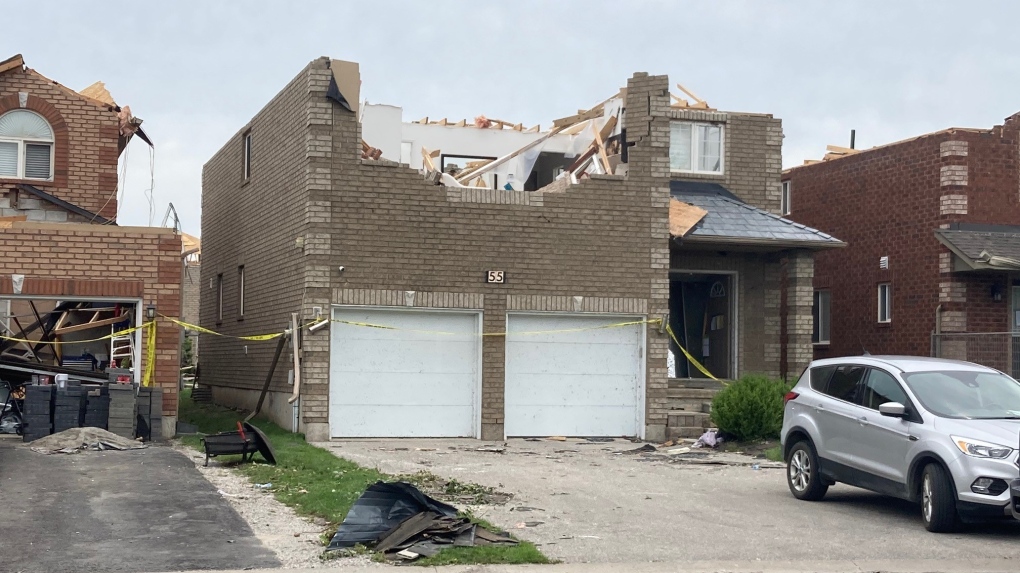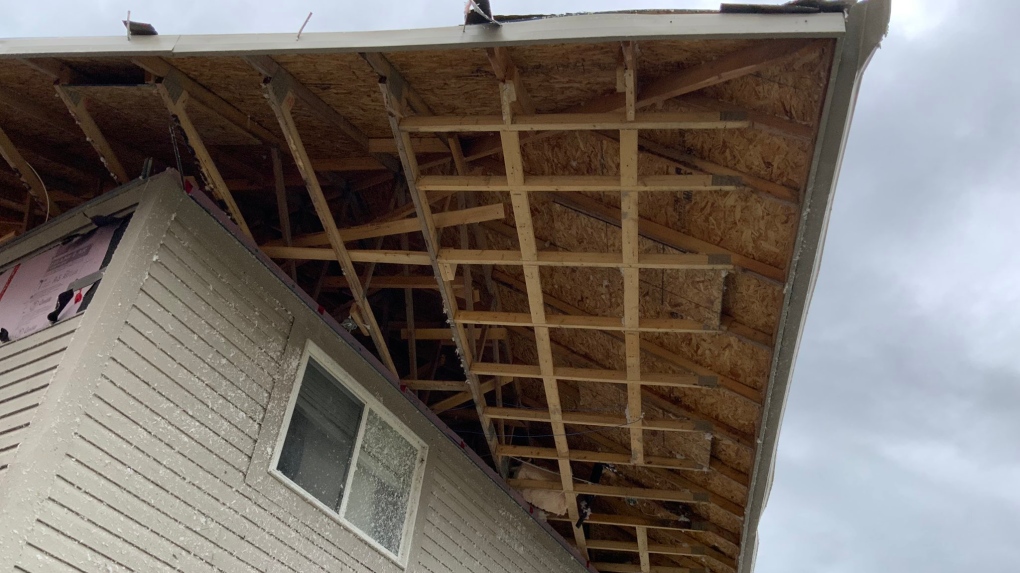Proposed Barrie developments to be built to withstand severe weather
The builder of two proposed developments in Barrie plans to include hurricane straps in its homes following the devastation of last year's tornado.
"It was initially a discussion we had with Counc. Natalie Harris and we brought it back to our construction team, sat down and talked about it and thought it was a good investment for our properties moving forward," said Nicole Sampogna, director of planning and development with StateView Homes.
The move is a first for StateView Homes, which said the small metal bracket would help its builds better withstand severe wind.
"When pressure increases inside the attic, the roof wants to lift," noted Tony Taurasi, StateView Homes' director of construction. "What the clips do is they actually mechanically fasten it to the load-barring walls keeping the structure from lifting up."
The decision follows the aftermath of the twister, which had wind speeds clocking in at 210 kilometres per hour, damaging upwards of 200 homes with roughly 20 roofs ripped away.
The devastation by the EF-2 tornado renewed calls to strengthen Ontario's building code.
"When you have the uplift, you have to hold (the roof) down, and our building code isn't great for that, and we can do a few relatively simple things to improve that," said Gregory Kopp, lead researcher with the Northern Tornadoes Project.
 A damaged home on Sat. July 17, 2021 after an EF-3 tornado passed through Barrie, Ont. (Katelyn Wilson/CTV News)
A damaged home on Sat. July 17, 2021 after an EF-3 tornado passed through Barrie, Ont. (Katelyn Wilson/CTV News)
 Researchers take pictures of damaged homes with "poor construction quality" in Barrie, Ont. following a tornado on July 15, 2021. (Gregory Kopp/Twitter)
Researchers take pictures of damaged homes with "poor construction quality" in Barrie, Ont. following a tornado on July 15, 2021. (Gregory Kopp/Twitter)
In May, the City of Barrie submitted what it calls a robust proposal to the province recommending changes, including hurricane straps and other joints within the wall down to the foundation.
"The hurricane straps are very beneficial for the joint between the roof and the wall, but we can't ignore all the other connections that go into tension," said Michael Janotta, Barrie's chief building official.
"If you think of your wall as being a link system, a chain, there are eight different joints that could fail within that chain, and each of those joints have a different strength. So what we want to do is make sure each link in that chain has enough strength to be able to resist a tornado," he continued.
Janotta said that the code currently deals with how to connect those joints but does not contemplate a house being built to resist that amount of uplift.
"Those joints are designed considering mostly downward loads, rather than upward loads, so when we have a complete load reversal, different things need to happen, and that's why we need to build it different," Janotta said. "Change is difficult, and there is always resistance to change, but I think they see the value in what we're proposing."
 Researchers take pictures of damaged homes with "poor construction quality" in Barrie, Ont. following a tornado on July 15, 2021. (Gregory Kopp/Twitter)
Researchers take pictures of damaged homes with "poor construction quality" in Barrie, Ont. following a tornado on July 15, 2021. (Gregory Kopp/Twitter)
According to the Insurance Bureau of Canada (IBC), across the country, insured losses from natural disasters over the last decade average $2.2 billion a year, far exceeding the average in the previous decade of $632 million.
"The severe weather that we are seeing is not the weather we saw 10 plus years ago, and we have to build our homes and buildings to withstand the types of events that we're seeing," said Anne Marie Thomas, IBC director of consumer and industry relations. "These events are not going away, so we should be making our buildings better."
"The cost of the straps ranges from $1.50 to $5 per strap, plus whatever it costs to do the installation, so it's a very little cost that adds so many benefits to the house. It's very relevant to have them implemented into all our projects now," Taurasi added.
A statement from Nazaneen Baqizada, spokesperson for the Ministry of Municipal Affairs and Housing, noted, "We are actively collaborating with the City of Barrie to complete their code change proposal and have also started engaging with the National Research Council on how the National Construction Codes and Ontario Building Code can be improved with better hurricane and tornado wind impact protection requirements moving forward."
As of now, no clear timeline has been given on when those changes, if any, would happen.
- DETAILS: Stories from the July 15, 2021, Barrie tornado
- PHOTO GALLERY: Destruction from tornado in Barrie community
- WATCH VIDEO: Videos and reports from the 2021 tornado
CTVNews.ca Top Stories

Calls for Ottawa to end Canada Post strike mount as businesses face challenges
As the Canada Post strike nears its three-week mark, stores across the country have turned to alternate measures to send products to paying customers and keep operations running smoothly.
Trump making 'joke' about Canada becoming 51st state is 'reassuring': Ambassador Hillman
Canada's ambassador to the U.S. insists it's a good sign U.S. president-elect Donald Trump feels 'comfortable' joking with Canadian officials, including Prime Minister Justin Trudeau.
Mexico president says Canada has a 'very serious' fentanyl problem
Foreign Affairs Minister Mélanie Joly is not escalating a war of words with Mexico, after the Mexican president criticized Canada's culture and its framing of border issues.
Search extends into the night for Pennsylvania woman who may have fallen into sinkhole
A grandmother looking for her lost cat apparently fell into a sinkhole that had recently opened above an abandoned western Pennsylvania coal mine and rescuers worked late into the night Tuesday to try and find her.
From niche grocer to supermarket giant: How T&T plans to repeat success in the U.S.
Canada's biggest Asian grocery chain is expanding into the U.S., hoping to bring its patented array of food, skin care and more to a new market.
South Korea's opposition parties submit a motion to impeach President Yoon over sudden martial law
South Korea's opposition parties Wednesday submitted a motion to impeach President Yoon Suk Yeol over the shocking and short-lived martial law that drew heavily armed troops to encircle parliament before lawmakers climbed walls to re-enter the building and unanimously voted to lift his order.
Freeland says it was 'right choice' for her not to attend Mar-a-Lago dinner with Trump
Deputy Prime Minister and Finance Minister Chrystia Freeland says it was 'the right choice' for her not to attend the surprise dinner with Prime Minister Justin Trudeau at Mar-a-Lago with U.S. president-elect Donald Trump on Friday night.
A list of mispronounced words provides a retrospective of 2024, from Kamala to Chappell
U.S. Vice President Kamala Harris and breakout pop star Chappell Roan were among the year's most talked-about people. Their names were also among the most mispronounced.
Quebec doctors who refuse to stay in public system for 5 years face $200K fine per day
Quebec's health minister has tabled a bill that would force new doctors trained in the province to spend the first five years of their careers working in Quebec's public health network.

































